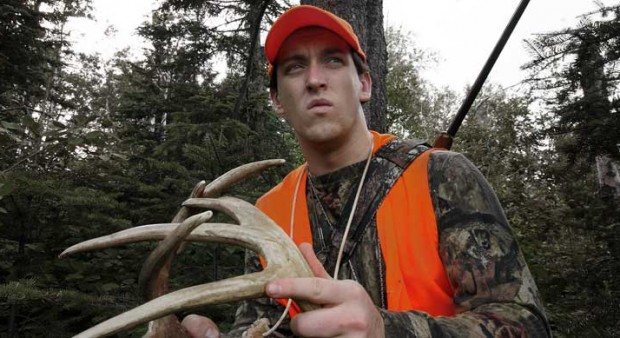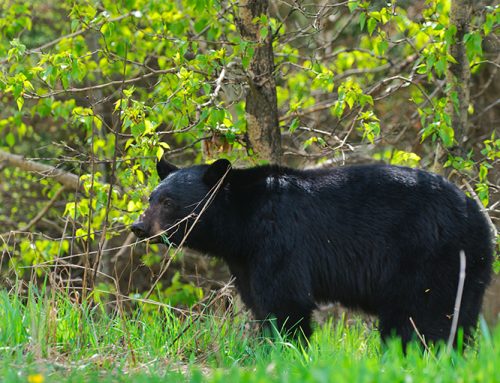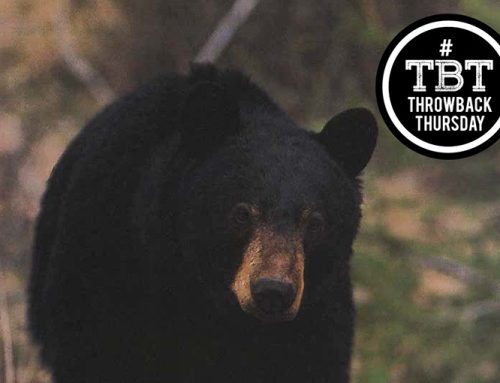
Author’s son, Devin Ellis, rattles with a pair of natural antlers.
The calling and rattling game is something many Ontario whitetail-deer hunters struggle with. Most hunters know that both techniques have merit, but the how and when of each remains something of a mystery to many. Over the years, I’ve been asked hundreds of questions about rattling and calling at deer-hunting seminars, so I know there’s interest across all parts of this province.
Along with my thoughts on the subject of rattling and calling, this article will share the insights of OOD Big Game Editor Drew Myers, who knows his way around the deer woods, and OOD Field Editor Jeff Gustafson, a Kenora-based guide and trophy buck specialist.
Rattling
First time rattlers often ask how long the rattling sequence should be as well as the wait in between. These are legitimate questions, and there are some guidelines, but there really is no wrong way to rattle a buck. That said, anytime you are calling or rattling, less is more. My average rattling sequence is a couple of minutes, followed by 15 or 20 minutes of silence. During this time I’m listening for animals approaching and watching for movement. Occasionally, a buck will run right in. More often than not, however, he will approach with caution. You might only catch the movement of a leg in the trees, or an ear flick. Bucks will usually approach downwind, but not always. I’ve had some big boys come to a rattle sequence directly in my wind.
As for the mechanics of rattling, you are just creating the illusion of two bucks fighting.
The easiest way to do this is to take two real deer antlers and slam them together. There’s a lot to be said for the sound of two natural antlers making noise. Yet there are other options. During the past ten years, a wide array of artificial rattling tools have come on the market. They vary from mesh rattle bags — usually filled with plastic or wood sticks — to full-size antler replicas made of a variety of artificial, but natural-sounding plastics. One company even makes artificial rattling antlers with two racks per side, to create a realistic illusion of two bucks fighting. The variety of sounds you can get from these tools is extraordinary, but our two experts still choose organic bones for their hunt.
“I prefer real antlers because I also use them to rake branches and pound the ground to simulate a real battle,” said Drew Myers. “I think they sound better. However, real antlers are a pain to carry.”
Myers adds if he is walking all day, or it’s a long way into his stand location, he uses a rattle bag or other rattling call, which is lighter and more packable.
“I’ve called just as many bucks in with a rattle bag as real antlers. The bags are likely a bit safer in crowded hunting woods,” he notes.
“Halloween seems to be the date that deer start really coming to the rattling sounds.”
“I really prefer real bones,” said Jeff Gustafson. “Although the fake ones sound pretty good, for me it’s just a sentimental, confidence thing. I have a couple sets of sheds that I made into rattling antlers.”
Gustafson says hunters who rattle should make sure they cut off the brow tines, which are flush with the main beams, so they don’t beat up their hands.
I prefer a rattle bag, both for carrying convenience and safety reasons. I’m wary about rattling real antlers on public land, and prefer the more subtle movements associated with a rattle bag. However, in a tree stand or ground blind, real antlers are louder and their sound carries farther. Real or fake, I always transport my antlers in a backpack, never around my neck.
Whether using a real or artificial rack, intersperse hard clashes with little tickles of the tips of the tines. This subtle technique creates a more natural fight scenario and can draw in even the wiliest old buck. Roll and clash rattle bags by hand. Keep in mind wood sticks in rattle bags tend to be louder than plastic.
When to rattle
As soon as whitetail bucks are out of velvet in September, the sparring begins. It’s small dustups at first, but as the rut approaches, the intensity grows. There’s a lot of sparring in late October and early November.
“The timing of my rattling is really dependent on a number of factors,” said Myers. “As far as the time of the year, Halloween seems to be the date that deer start really coming to the rattling sounds.” Myers says they can come earlier, but from October 31st to about the 20th of November seems to be the best time.
“Within that time frame, there are normally two or three days where rattling really works well, but the dates vary from year to year,” he added.
Gustafson says the best scenario for rattling is having a two-man team. One person gets into some thick cover, rattles, and makes a bunch of noise smashing branches, while the shooter hides out in the open with the best viewpoint of the area being hunted. He says this helps you cheat the wind a little bit as well. “My clients have taken some good bucks over the years using this strategy,” he said.
When not to rattle
There are times when rattling may not serve you well. It may even hurt you.
I once watched a medium-sized 8-point buck work its way through a cut, nose to the ground. It was a decent buck, a potential shooter, but it was also early in the hunt. So I tried a little experiment. I had two rattle bags, one with plastic sticks and a larger one with wooden sticks. A few clashes of the plastic rattle bag stopped the deer. It stood for quite a while and then began to slowly approach my position. I then clashed the louder bag of wooden sticks. That buck stopped again, turned tail and ran, white flag waving. Was the bag too loud or was the buck afraid to get beaten by a bruiser? All I can tell you is the same kind of rattle bag called in a record book 13-point buck for my father 7 years ago. That monster was not scared off by the loud crash of the wooden rattle bag.
The animal had become so excited by the call that at one point the buck was 5 feet from him.
“I don’t rattle if a deer I want to shoot is coming my way, because rattling might stop it, or put its focus on me,” said Myers. “Also, I don’t rattle when I’m trying to fill an antlerless tag. I’ve seen lots of does that want nothing to do with two bucks fighting — especially early in the season before they’re ready to breed.”
Gustafson says a strong wind is bad when you’re rattling, because you will not be able to get your sound out very far and the deer will get your wind too easily. “They will nearly always approach you with the wind to their advantage,” he said. “If it’s a light wind, you can sometimes trick them. But if it’s howling, it’s tough.”
In my experience, rattling in the rain doesn’t work well either. I’m talking about a heavy rain, not just a fine mist or drizzle. However, big bucks have come to the rattle in what I’d consider heavy snow in a light wind.
My best rattling period has been the first week of November.
Calling
It’s amazing to think that calling deer was practically unheard of twenty years ago. My grandfather, Ora Ellis, shot 150 plus deer in his life and never called or rattled a single one of them. There was no such thing. Deer were mostly pushed by people, or dogs and shot on the run. Today, thousands of deer hunters stay still and call deer to them using a variety of sounds. These calls include fawn and doe bleats, bucks grunts, and even what amounts to a buck wheeze.
So when should a deer hunter use a call? And how? As you might expect, opinions on this subject vary. There is pretty much unanimous agreement among modern deer hunters though, that calling can be an effective tool. That’s certainly the case with Myers and Gustafson.
“The grunt call is a must-have from opening day to the last day,” said Myers. “I don’t have a favourite brand, but I do like a call with a higher pitch than others.”
Myers says he likes his grunt to sound like the deer equivalent of Michael Jackson, as opposed to Sean Connery. He feels a deeper grunt could intimidate some deer. “You can often play around with the reeds in the calls until you get the sound you like,” he said.
Gustafson agrees with Myers about the grunt, but expands his repertoire to include the sounds of antlerless deer as well.
“I’ll sometimes mix a grunt tube or a doe bleat in with my sessions. I like to go with the feel of things,” said Gustafson. “I always have a grunt tube with me to at least stop a deer that may be trotting through.”
For me, the grunt tube has been the most consistent producer of quality bucks over the past few years. I concur with Myers that a grunt tube with a reedier, higher-pitched sound is more effective most of the time.
OOD’s other Big Game Editor Bruce Ranta, a trophy buck specialist, turned me on to this concept many years ago during a Kenora area hunt. He told me he believed a smaller sounding grunt would attract all bucks, including the monarchs. This means more potential deer interactions during the course of a hunting season. His advice has held true.
As for doe calls and bleats, they can be effective, particularly as the rut heats up and bucks start sniffing around. My oldest son, Devin, once had an 8-point buck cross 300 hundred yards of open country to his doe-bleat-in-a-can call. The animal had become so excited by the call that at one point the buck was 5 feet from him.
Where to find Whitetails
When not to call
The key with calling is to have calm or light winds. If it’s windy, your call — no matter what type it is — will not be heard. Deer have excellent hearing, but not so good that they can hear a soft blow on a tube in the middle of a big, windy forest. So keep the calls in your pocket when it’s windy. Otherwise, calling is a tool that can work during all parts of the deer-hunting season, including well into December. I once grunted an 8-point buck out of the bush in knee-deep snow. I shot it at 50 feet.
Calling and rattling
Like a peanut butter cup, you can mix two good things together and get an even better final product. Rattling and calling with a grunt tube at the same time works well, as the two sounds create a sonic blend that’s familiar to a dominant buck. Try rattling with your hands and calling with your mouth, interspersing soft grunts as you clash antlers. Southern Ontario based OOD Bass Editor and avid deer hunter Luigi De Rose (see sidebar) is a fan of the call-and-rattle sound mix.
“I always use a grunt tube and rattle at the same time,” said De Rose. “I start with a few grunts and then rattle. I usually finish the sequence with a few extra grunts. I try to think how the fight would take place: the beginning, middle, and end.”
Using a call to draw attention away from unwanted noise in the woods is another good ploy. This helps reassure nervous bucks that a loud crack is not a hunter, but another deer.
“Sometimes when I’m moving from location to location I’ll hit the grunt tube,” said Gustafson. “Especially after I break a branch or make some noise. I’ve had deer approach me in some thick cover because they hear a noise and some grunting.”
This is really just the proverbial tip of the iceberg when it comes to rattling and calling for trophy bucks. There’s much to learn about how bucks react to rattling and calling. This fall, why not join the converted and add the rattle and call to your bag of tricks? You may just bring in the largest buck of your life.






I’ve been a serious deer hunter for over 35 years. I’ve always been willing to try new techniques, so when I heard about grunt calls in 1987, I was quick to buy one and I’ve used it every year since. When used properly, they can tip the scales in your favour and I could write a several pages of testimony. If I could add one point to Gord’s article is don’t call a buck that you see but don’t intend to kill. Sure it’s fun to fool them, but you run the risk of educating and making them harder to hunt. One of the benefits of not alerting a deer is that it gives you an opportunity to watch and learn deer behaviour.